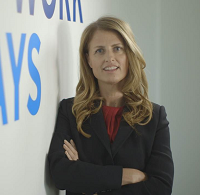SIX CONSIDERATIONS FOR HR LEADERS WHEN SWITCHING TO A HYBRID WORKING MODEL
Sandra Henke Group Head of People and Culture, Hays

As the restrictions that were put in place across the world to combat COVID-19 begin to be lifted and plans to transition back into the office are underway, we can expect a very different workplace to the one we left behind and a different way of working. So, what do HR departments need to consider as they begin this transition?
The phased return to the workplace will be a slow one and not all workers will be able to go back to the office at once. This will lead to a hybrid working model, with some employees working from the office and others working from home, or a mixture of the two. HR leaders will be presented with multiple challenges during this time and will need to find solutions to ensure their people remain happy and productive.
Ensuring our workplaces are safe
Before we start exploring these considerations, first and foremost is the health and safety of all workers, both physical and psychological. This needs to be at the forefront of all decisions made in relation to the workplace. Many employees will feel anxious about returning to the office and business leaders will need to manage their concerns.
An immediate redesign of the office will therefore be needed to ensure it is safe. Work stations will have to allow people to sit the required distance apart without people entering each other’s personal space. Common areas such as meeting rooms, receptions, kitchens and toilets will need a rethink, sanitiser gel will need to be readily available and rules on shared spaces clearly communicated.
As a result of these changes, the office space may not be available to accommodate all employees, as it once did, and some employees will decide to work from home for longer for many different reasons. However, most have proven over the past few months that we are capable of working from home and while the amount of time you spend working remotely may change as a result, I don’t expect to see a radical shift, because we are humans who crave contact, so the office space isn’t going to disappear entirely.
What to consider when transitioning your business to hybrid working
As I’ve said, for most organisations, phasing their employees back to the workplace will be a slow process, with a growth in hybrid teams likely to emerge as a result. But working in this way is new to many of us, so what should HR teams be considering as they plan for this new way of working?
The questions and considerations appear to be endless. When you are operating a hybrid model, what role does physical space and technology play? How do you then build and maintain a culture, one that sustains trust and builds on fun and productivity? How do you consider the principle of inclusion when most of the workforce isn’t physically in an office, how do you ensure their voice is still heard? How do you manage performance effectively? How do you celebrate key milestones and successes? These are just some of the questions and considerations me and my team have asked ourselves recently.
1. How can you build and maintain the culture of your business?
Many organisations spend years building the culture of their company, it is the foundation of any business, exhibiting who they are and why they do what they do. So how do you not only reinforce that culture, but build on it too in a newly hybrid working world?
How we engage with one another is absolutely central to any consideration of organisational culture and how we work together moving forward. Ensure you have regular weekly team catch-ups, everybody should be accustomed to video conference calls by now. Make sure they’re not all strictly work related either, having fun and sharing success should be a key aspect any organisations culture. So, continue to use technology to keep in contact and make sure there is a sharing of good news stories from across the team and business.
It can take adversity and challenging circumstances to remind you of how deep the spirit and culture of a company is. I think there’s something quite beautiful in the obstacles reinforcing that aspect of our culture, not changing it, just reminding us of how important it is, so how we go forward with that having been deepened and enriched in our culture. For instance, what really became apparent for us at Hays during the early days of the crisis was how resilient we are to challenges. There was also a real ‘hands to the pump’ attitude I witnessed across the globe that ensured we were able to make the jump to remote working swiftly and without major disruption.
2. Inclusion becomes even more important
When the majority or some of your workforce isn’t present in the office, inclusion becomes more important than ever. Just because you can’t see someone, that doesn’t mean they aren’t there and an equal part of the team. The definition of diversity and inclusion itself starts to change right now because everyone’s had a diverse experience during the pandemic. This could be due to their living situation, or even the kind of work and responsibilities they have been given. People will be returning to the office with different experiences and potentially different viewpoints.
Make sure you have the necessary open channels of communication, so employees are able to voice their concerns or provide feedback. Ensure all employees, no matter where they are based, are taking part in company and team activities, so they don’t feel left out. Remind your team that you are all in it together, every employee – whether they are in the office or at home – has a role to play in sustaining the company’s culture in the next era of work.
3. Making employee wellbeing a priority
Everybody’s remote working experience is unique to them, everybody will have been facing different challenges while in lockdown, whether that is due to other commitments such as childcare, isolation or limited space to work. Many will be concerned about their finances and the health and wellbeing of loved ones. This is in addition to the concerns people may have about returning to the workplace or continuing to work from home, all of which could have a considerable effect on the mental health and wellbeing of your employees.
Consider the frequency with which staying in touch with people and ensure you are providing them with the opportunity to be vulnerable. This will become increasingly difficult when you aren’t seeing your employees on a regular basis. In this situation you can’t just assume because someone is getting on with things that they are ok. Personally, that is something I have learnt during this period, so I have started connecting with peers and colleagues more often and reaching out to them.
The current crisis will have no doubt negatively impacted a number of people and it has the potential to manifest itself overtime. So, I think at a time when we understandably are talking about mental health and anxiety a lot, we need to be incredibly mindful and careful, and exercise our duty of care around caring for people who are struggling or who have had a hard time.
4. What’s the best way to promote collective ownership?
Collective responsibility is essential to ensuring the workplace is a safe place for everyone. When an organisation opens up its physical workspace, clearly the employer has a responsibility to make sure all their employees are as safe as possible and that all the necessary measures are in place around social distancing, health and hygiene.
However, it requires every single person in your organisation to share that collective responsibility.
So, this notion of all being in it together becomes very real – not just some hashtag – we actually are stronger together because every human in the workplace has a role to play in creating a safe workplace through their own behaviour. It’s far less top-down than trying to enforce other behaviours and far more about emphasising that every individual has their part to play in creating an environment that brings everyone together and brings everyone together safely, remotely or physically.
5. Should you increase your focus on learning and development?
Another key area is from a learning and development point of view – how can you structurally ensure that your leaders, and managers of people in particular, are equipped to deal with this new way of working? Your training programmes must prepare them with the necessary tools to manage a hybrid workforce. You will also have to consider whether your existing training is sufficient for your employees and the skills they will need in the new era of work.
But what does training look like when you can’t bring everyone together in a classroom? From our own experience over the past couple of months, you have to treat it completely differently to training that is delivered onsite in a single room. You will have to work harder to keep people’s attention, so consider making it easier to digest by breaking the training up into segments. Adapt the training you already have to complement this new era of work and ensure you are focusing on the necessary skills which may be currently lacking, if you are using more technology than usual make sure your people know how to use it for instance.
6. How important is preparing for change?
At Hays, we have spent the last few years really focusing on preparing for change and being change confident. So, a lot of our time and energy was spent looking at how we manage change effectively and what the future might look like. We even built a leadership programme predominantly focusing on building collaboration, innovation and encouraging change confidence. During this crisis, we have found our leaders having to use all of the tools and techniques they learnt on the programme, and under pressure. Because of this focus on equipping our leaders to feel confident in managing change, we were able to adapt quickly and be agile to the fast-moving situation. The training has really had life breathed into it, and in a way none of us could have anticipated.
The past few months have really demonstrated how important preparing for change is. It’s equipped us as a business really well and I would encourage other businesses and leaders to do the same. After all, you never know what changes your business may have to go through in the future.
It’s important to remember that it is a learning curve for all of us too, there is not a leader in the world right now who doesn’t look back on the last couple of months and think, “I could have done that better.” At the end of the day, we’re all human and we’re all figuring a lot of this stuff out as we go.
This is quite an extraordinary time for us all, so if we allow ourselves to stand back and reflect on that it gives us plenty of opportunity to consider how we work, to question what worked before, what you want to take into the new hybrid working world with us. That’s quite a unique and fortunate position to find ourselves in as HR leaders.
AUTHOR
 Sandra Henke is the Group Head of People and Culture at Hays. She is a member of the Management Board with responsibility for leading People and Culture strategy and best practice. Her key area of focus is to continue to evolve our culture and people practices, with a specific focus on Diversity and Inclusion, Change Management, Leadership and Talent Development, Succession, Management Skills and Employee Engagement. She has a long-standing passion for the role that leadership and cultural development play in shaping organisational and human success. Born and bred in New Zealand, Sandra has worked for Hays for the past 20 years, originally in Australia where her last role was as HR Director for the Asia Pacific region. She moved to London in 2012 to take up a role in the UK&I and was promoted to the Group Management Board in 2017.
Sandra Henke is the Group Head of People and Culture at Hays. She is a member of the Management Board with responsibility for leading People and Culture strategy and best practice. Her key area of focus is to continue to evolve our culture and people practices, with a specific focus on Diversity and Inclusion, Change Management, Leadership and Talent Development, Succession, Management Skills and Employee Engagement. She has a long-standing passion for the role that leadership and cultural development play in shaping organisational and human success. Born and bred in New Zealand, Sandra has worked for Hays for the past 20 years, originally in Australia where her last role was as HR Director for the Asia Pacific region. She moved to London in 2012 to take up a role in the UK&I and was promoted to the Group Management Board in 2017.


